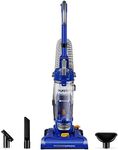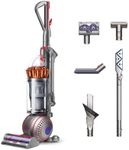Buying Guide for the Best Lightweight Upright Vacuums
Choosing a lightweight upright vacuum can make cleaning your home much easier, especially if you have multiple floors or need to carry the vacuum around often. The goal is to find a vacuum that is easy to maneuver, effective at cleaning your specific floor types, and comfortable for you to use. When comparing models, focus on the features that matter most for your living space and cleaning habits.WeightWeight refers to how heavy the vacuum is, and it's a crucial factor for ease of use, especially if you need to carry it up and down stairs or move it around frequently. Lightweight vacuums typically range from about 5 to 15 pounds. The lighter the vacuum, the easier it is to handle, but sometimes very light models may sacrifice some cleaning power or capacity. If you have mobility concerns or a large home with stairs, aim for the lower end of the weight range. If you need a bit more power and don't mind a little extra heft, a slightly heavier model might be suitable.
Suction PowerSuction power determines how effectively the vacuum can pick up dirt and debris from your floors. This is often measured in air watts or simply described in product details. Higher suction power is better for deep cleaning carpets, while moderate suction is usually enough for hard floors. If your home has mostly carpets or pets that shed, prioritize higher suction. For mostly hard floors or light cleaning, a moderate level will suffice and may be quieter and more energy-efficient.
Filtration SystemThe filtration system captures dust and allergens, preventing them from being released back into the air. HEPA filters are the gold standard, trapping very fine particles and making them ideal for allergy sufferers. Some vacuums use standard filters, which are fine for general cleaning but may not be as effective for those with allergies or asthma. If air quality is a concern, look for a vacuum with a HEPA or similarly advanced filter. Otherwise, a standard filter may be adequate for everyday use.
Corded vs. CordlessThis refers to whether the vacuum needs to be plugged in during use (corded) or runs on a rechargeable battery (cordless). Cordless vacuums offer more freedom of movement and are easier to use in areas without outlets, but they have limited run time before needing a recharge. Corded vacuums provide continuous power but can be less convenient to move around. If you have a small to medium space or want quick, hassle-free cleaning, cordless may be best. For larger areas or longer cleaning sessions, a corded model might be more practical.
Dustbin or Bag CapacityThis is the amount of dirt and debris the vacuum can hold before it needs to be emptied or have the bag replaced. Smaller capacities mean more frequent emptying, which can be inconvenient for larger homes or heavy cleaning. Larger capacities are better for big spaces or if you prefer less maintenance. If you clean often or have a small home, a smaller dustbin or bag may be fine. For less frequent cleaning or larger areas, look for a model with a bigger capacity.
Floor Type CompatibilitySome vacuums are better suited for certain floor types, such as carpets, hardwood, or tile. Many lightweight uprights are designed to handle multiple surfaces, but some may perform better on one type than another. If your home has mostly one type of flooring, choose a vacuum optimized for that surface. If you have a mix, look for a model with adjustable settings or brush rolls that can be turned on or off to protect delicate floors.
Maneuverability and DesignThis covers how easy the vacuum is to steer around furniture and tight spaces. Features like swivel steering, a low-profile head, and ergonomic handles can make a big difference in comfort and efficiency. If you have a lot of furniture or tight corners, prioritize models with enhanced maneuverability. For open spaces, this may be less critical.

















